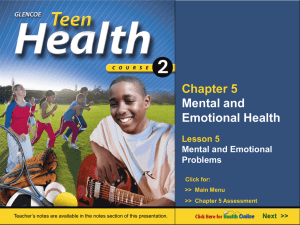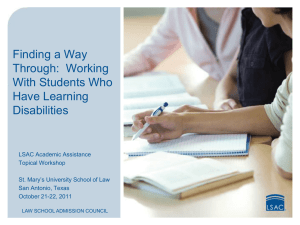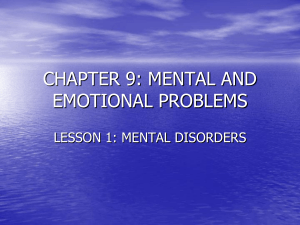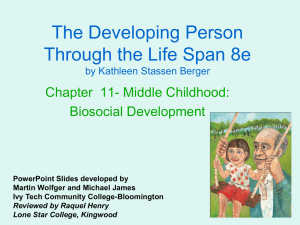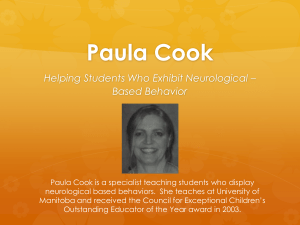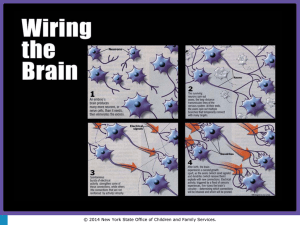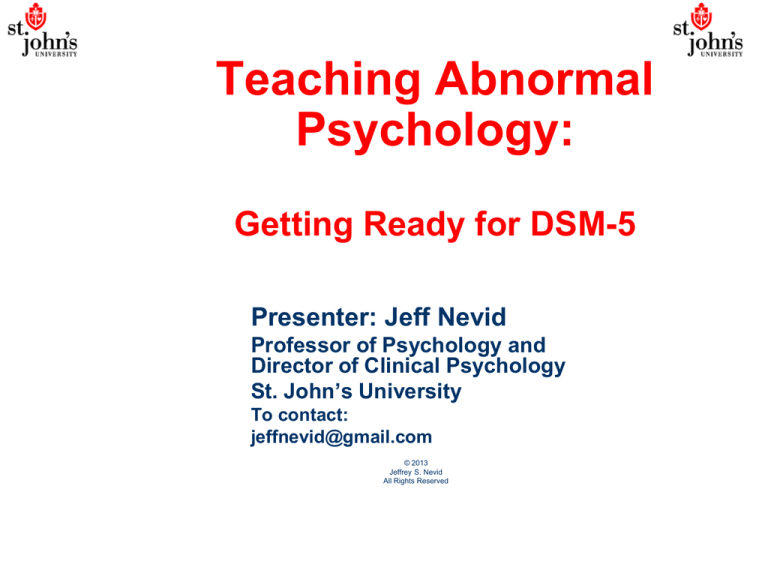
Teaching Abnormal
Psychology:
Getting Ready for DSM-5
Presenter: Jeff Nevid
Professor of Psychology and
Director of Clinical Psychology
St. John’s University
To contact:
jeffnevid@gmail.com
© 2013
Jeffrey S. Nevid
All Rights Reserved
What are your goals in teaching
abnormal psychology?
To help students distinguish abnormal from normal behavior
and acquire a better understanding of abnormal behavior
patterns
To put a human face on the study of abnormal psychology and
increase student sensitivity to the struggles of people suffering
from these types of problems
To better understand the biological and psychosocial roots of
abnormal behavior
To better understand how psychological or mental disorders are
classified and treated
What the undergraduate abnormal
psychology course is not. . .
A psychodiagnostic seminar
A training course in the DSM
A seminar in case conceptualization and
differential diagnosis
An exhaustive cover-to-cover study of the
DSM manual
A Short History of the DSM
The DSM-1 (1952), 106 disorders across several major
categories, reflecting a psychodynamic perspective on
etiology
DSM II (1968), 182 disorders, similar framework as DSM1; like DSM-1, it lacked specification of specific
symptoms of many disorders; distinguished among
disorders at broader levels of neurosis, psychosis, and
personality disturbance
DSM-III (1980) and DSM-III-R (1987), which focused on
standardization of diagnostic categories by linking them
to specific criteria or symptom clusters, expressed in
colloquial language; included 265 diagnoses in DSM-III
and 292 in DSM-III-R, which changed some of the
diagnostic criteria
DSM-IV (1994) and DSM-IV-TR (2000), 297 disorders,
relatively minor changes
Major Changes
Change
Comment
Elimination of multiaxial system and GAF Clinicians wanted simplified, diagnosisbased system; distinctions between Axis
I and Axis II disorders were never clearly
justified; clinicians can still specify
external stressors; new assessment
measures will be introduced
Establishes 20 diagnostic classes or
categories of mental disorders
Categories based on groupings of
disorders sharing similar characteristics;
some categories represent spectrums of
related disorders
Introduction of new diagnostic category
of Neurodevelopmental Disorders to
include Autism Spectrum Disorder and
ADHD and other disorders reflecting
abnormal brain development
Increasing emphases on neurobiological
bases of mental disorders and the
developing understanding that abnormal
brain development underlies many types
of disorders
Major Changes
Change
Comment
Introduces more dimensionality (severity
ratings) but does not restructure
personality disorders as some had
proposed
Major changes in personality disorders
held over until next revision, the DSM
5.1 (or maybe 5.2)
Roman numerals dropped: DSM-5, not
DSM-V
Allows for easier nomenclature for
midcourse revisions, 5.1, 5.2, etc.
Removes obsessive-compulsive disorder
from category of Anxiety Disorders and
places it in new category of ObsessiveCompulsive and Related Disorders
Recognizes a spectrum of obsessivecompulsive type disorders, including
body dysmorphic disorder; however,
anxiety remains the core feature of OCD,
so questions remain about separating it
from anxiety disorders
Major Changes
Change
Comment
Removes ASD and PTSD from Anxiety
Disorders and places them in new
category of Trauma and Stressor-Related
Disorders
Groups all stress-related psychological
disorders under the same umbrella;
Adjustment Disorders may now be coded
in context of traumatic stressors
Creates new diagnostic category of
Substance-Related and Addictive
Disorders
Now includes Gambling Disorder
(previously Pathological Gambling) but
other forms of nonchemical addiction,
such as compulsive Internet use and
compulsive shopping, don’t make it into
the manual and remain under study
Eliminates distinction between substance
abuse and dependence disorders,
collapsing them into single category of
substance use disorders
Recognizes that there is no clear line
between substance abuse and
dependence disorders; also brings
certain compulsive patterns of behavior
into a spectrum of addictive disorders
Major Changes
Change
Comment
Provides a means of rating severity of
symptoms, such as for ASD
Encourages clinicians to recognize the
dimensionality of disorders
Greater emphasis on comorbidity; e.g.,
use of anxiety ratings in diagnosing
depressive and bipolar disorders
Provides more explicit recognition of
comorbidity in having clinicians rate
level of anxiety in mood disorders
Major Changes
Change
Comment
Elimination of term “somatoform
disorders” (now Somatic Symptom and
Related Disorders)
Eliminates a term few people
understood (somatoform disorders) and
now emphasizes the psychological
reactions to physical symptoms, not
whether they are medically based
Reorganization of mood disorders into
two separate diagnostic categories of
Depressive Disorders and Bipolar and
Related Disorders
No major changes anticipated, but no
clear basis for eliminating umbrella
construct of mood disorders
Major Changes
Change
Comment
Removal of developmental
trajectory in organizing
classification of disorders:
Eliminates category of
“Disorders Usually First
Diagnosed in Infancy,
Childhood, or Adolescence”
May make it easier to diagnose traditional childhood
disorders like ADHD and even separation anxiety
disorder in adults. Conversely, it may also make it
easier to diagnose disorders typically seen in adults,
like bipolar disorder, in children.
The new category of Neurodevelopmental Disorders
includes many disorders previously classified as
childhood onset disorders, however it excludes
disorders involving abnormal emotional development,
such as separation anxiety disorder and selective
mutism.
Where does this new classification leave the study of
child psychopathology?
Elimination of bereavement
exclusion from major
depression
Recognizes that a major depressive episode may
overlay a normal reaction to loss; critics claim it may
pathologize bereavement
Major Changes
Change
Comment
Hypochondriasis dropped as distinct
disorder
Eliminates the pejorative term
“hypochondriasis”; people formerly
diagnosed with hypochondriasis may now
be diagnosed with Somatic Symptom
Disorder if their physical symptoms are
significant or with Illness Anxiety Disorder
if their symptoms are minor or mild
Factitious Disorder moved to Somatic
Symptom and Related Disorders
Associated with other somatic symptom
disorders, but is distinguished by
intentional fabrication of symptoms for no
apparent gain other than assuming
medical patient role
Diagnostic Categories
Diagnostic Category
Examples of Specific Disorders
Neurodevelopmental Disorders
Autism Spectrum Disorder
Specific Learning Disorder
Communication Disorders
ADHD, Motor Disorders, etc.
Schizophrenia Spectrum and Other
Psychotic Disorders
Schizophrenia
Schizophreniform Disorder
Schizoaffective Disorder
Delusional Disorder
Schizotypal Personality Disorder
Bipolar and Related Disorders
Bipolar I Disorder, Bipolar II Disorder
Cyclothymic Disorder
Depressive Disorders
Disruptive Mood Dysregulation Disorder
Major Depressive Disorder
Persistent Depressive Disorder
Premenstrual Dysphoric Disorder
Diagnostic Categories
Diagnostic Category
Examples of Specific Disorders
Anxiety Disorders
Specific Phobia
Social Anxiety Disorder (Social Phobia)
Panic Disorder
Agoraphobia
Generalized Anxiety Disorder
Separation Anxiety Disorder
Selective Mutism
Obsessive-Compulsive and Related
Disorders
Obsessive-Compulsive Disorder
Body Dysmorphic Disorder
Hoarding Disorder
Hair-Pulling Disorder (Trichotillomania)
Excoriation (Skin-Picking) Disorder
Trauma and Stressor Related Disorders
Adjustment Disorders
Acute Stress Disorder
Posttraumatic Stress Disorder
Reactive Attachment Disorder
Disinhibited Social Engagement Disorder
Diagnostic Categories
Diagnostic Category
Examples of Specific Disorders
Dissociative Disorders
Dissociative Identity Disorder
Dissociative Amnesia
Depersonalization/Derealization Disorder
Somatic Symptom and Related
Disorders
Somatic Symptom Disorder
Illness Anxiety Disorder
Conversion Disorder (Functional Neurological
Symptom Disorder)
Factitious Disorder
Feeding and Eating Disorders
Anorexia Nervosa
Bulimia Nervosa
Binge Eating Disorder
Pica, Rumination Disorder
Avoidant/Restrictive Food Intake Disorder
Elimination Disorders
Enuresis
Encopresis
Diagnostic Categories
Diagnostic Category
Examples of Specific Disorders
Sleep-Wake Disorders
Insomnia Disorder
Hypersomnolence Disorder
Narcolepsy
Breathing-Related Sleep Disorders
Circadian Rhythm Sleep-Wake Disorders
Parasomnias: Sleepwalking, Sleep Terrors,
Nightmare Disorder, Rapid Eye Movement Sleep
Behavior Disorder
Restless Legs Syndrome
Sexual Dysfunctions
Delayed Ejaculation
Erectile Disorder
Female Orgasmic Disorder
Female Sexual Interest/Arousal Disorder
Genito-Pelvic Pain/Penetration Disorder
Male Hypoactive Sexual Desire Disorder
Premature (Early) Ejaculation
Diagnostic Categories
Diagnostic Category
Examples of Specific Disorder
Gender Dysphoria
Gender Dysphoria
Disruptive, Impulse-Control, and
Conduct Disorders
Oppositional Defiant Disorder
Intermittent Explosive Disorder
Conduct Disorder
Antisocial Personality Disorder
Pyromania
Kleptomania
Substance-Related and Addictive
Disorders
Substance Use Disorders
Substance-Induced Disorders
Gambling Disorder
Neurocognitive Disorders
Delirium
Major & Mild Neurocognitive Disorders
Diagnostic Categories
Diagnostic Category
Personality Disorders
Examples of Specific Disorders
Paranoid Personality Disorder
Schizoid Personality Disorder
Schizotypal Personality Disorder
Antisocial Personality Disorder
Borderline Personality Disorder
Histrionic Personality Disorder
Narcissistic Personality Disorder
Avoidant Personality Disorder
Dependent Personality Disorder
Obsessive-Compulsive Personality Disorder
Diagnostic Categories
Diagnostic Category
Examples of Specific Disorders
Paraphilic Disorders
Voyeuristic Disorder
Exhibitionistic Disorder
Frotteuristic Disorder
Sexual Masochism Disorder
Sexual Sadism Disorder
Pedophilic Disorder
Fetishistic Disorder
Transvestic Disorder
Other Mental Disorders
Other Specified Mental Disorder due to Another
Medical Condition
The (Dearly?)Departed:
Dropped or Consolidated Diagnoses
–
–
–
–
–
–
–
–
–
–
–
Somatization Disorder (gone)
Amnestic Disorders (amnesia now a feature of neurocognitive disorders)
Dissociative Fugue (now a subtype of dissociative amnesia)
Pain Disorder (gone)
Hypochondriasis (cases now divided between Somatic Symptom Disorder
and Illness Anxiety Disorder depending on severity of physical symptoms)
Asperger’s Disorder (may now be diagnosed as ASD)
Childhood Disintegrative Disorder (may now be diagnosed as ASD)
Pervasive Developmental Disorder NOS (may now be diagnosed as ASD)
Vaginismus and Dyspareunia (now Genito-Pelvic Pain/Penetration
Disorder)
Gender Identity Disorder (now Gender Dysphoria)
Sexual Aversion Disorder (dropped, most cases reclassifiable as specific
phobia)
Graduation Day:
Moving On Up (and out of the Appendix)
Binge Eating Disorder
Premenstrual Dysphoric Mood Disorder
Mild Neurocognitive Disorder
Caffeine Withdrawal
Factitious Disorder by Proxy (now called
factitious disorder imposed on another)
Name Changes
Was (DSM-IV)
Will Now Be (DSM-5)
Gender Identity Disorder
Gender Dysphoria
Sleep Disorders
Sleep-Wake Disorders
Dysthymic Disorder
Persistent Depressive Disorder
(Dysthymia)
Learning Disorders
Specific Learning Disorder
Stuttering
Child Onset Fluency Disorder
(Stuttering)
Phonological Disorder
Speech Sound Disorder
Mental Retardation
Intellectual Disability (Intellectual
Developmental Disorder)
Depersonalization Disorder
Depersonalization/Derealization
Disorder
Hypersomnia
Hypersomnolence Disorder
Name Changes (continued)
Was (DSM-IV)
Will Now Be (DSM-5)
Circadian Rhythm Sleep Disorder
Circadian Rhythm Sleep-Wake
Disorder
Breathing-Related Sleep Disorder
Obstructive Sleep Apnea Hypopnea
Syndrome, Central Sleep Apnea, or
Sleep-Related Hypoventilation
Primary Insomnia
Insomnia Disorder
Male Orgasmic Disorder
Delayed Ejaculation
Premature Ejaculation
Premature (Early) Ejaculation
Male Erectile Disorder
Erectile Disorder
Female Sexual Arousal Disorder
Female Sexual Interest/Arousal
Disorder
Hypoactive Sexual Desire Disorder
Now either Male Hypoactive Sexual
Desire Disorder or Female Sexual
Interest/Arousal Disorder
Name Changes (continued)
Was (DSM-IV)
Will Now Be (DSM-5)
Sleepwalking Disorder, Sleep Terror Non-Rapid Eye Movement Sleep
Disorder
Arousal Disorders: Sleepwalking,
Sleep Terrors
Social Phobia
Social Anxiety Disorder (Social
Phobia)
Autistic Disorder
Autism Spectrum Disorder
New Kids on the Block:
Newly Diagnosed Disorders
Disruptive Mood Dysregulation Disorder
Somatic Symptom Disorder
Illness Anxiety Disorder
Hoarding Disorder
Excoriation (Skin-Picking Disorder)
Disinhibited Social Engagement Disorder
Avoidant/Restrictive Food Intake Disorder
Social (Pragmatic) Communication Disorder
Restless Leg Syndrome
Rapid Eye Movement Sleep Behavior Disorder
Controversies
Point of Controversy
Concerns
Expansion of diagnosable Net result of diagnostic inflation may be to greatly
disorders
expand the numbers of people labeled as suffering from
a mental disorder or mental illness; e.g., Mild
Neurocognitive Disorder may pathologize mild cognitive
changes or everyday forgetting in older adults; e.g.,
Disruptive Mood Dysregulation Disorder may
pathologize repeated temper tantrums in children
Changes in classification
of mental disorders
Critics question whether changes in classification are
justified and might lead to greater diagnostic confusion;
parents of Asperger’s children are concerned their
children may not qualify for the new ASD diagnosis and
associated treatment benefits
Controversies
Point of Controversy
Concerns
Changes in diagnostic criteria
for particular disorders
Critics contend that many of the changes in the
diagnostic criteria have not been sufficiently
validated. Particular concerns are raised about the
substantial changes made in the set of symptoms
used to diagnose Autism Spectrum Disorders,
which may have profound effects on the numbers
of children identified as suffering from these
disorders
Process of development
Critics claim development of the DSM-5 was
shrouded in secrecy, that it failed to incorporate
input from many leading researchers and scholars
in the field, and that changes to the diagnostic
manual were not clearly documented based on an
adequate body of empirical research
Thank you!
Please share with me your ideas about teaching abnormal
psychology:
jeffnevid@gmail.com
3 / 28




